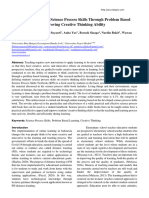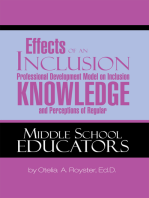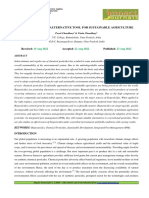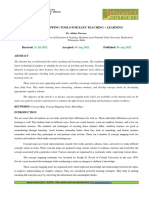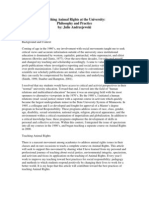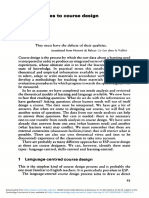29-02-2020-1582980347-6-IMPACT - IJRBM-1. IJRBM-A Study of Students Opinion About Indian Education System PDF
29-02-2020-1582980347-6-IMPACT - IJRBM-1. IJRBM-A Study of Students Opinion About Indian Education System PDF
Uploaded by
Impact JournalsCopyright:
Available Formats
29-02-2020-1582980347-6-IMPACT - IJRBM-1. IJRBM-A Study of Students Opinion About Indian Education System PDF
29-02-2020-1582980347-6-IMPACT - IJRBM-1. IJRBM-A Study of Students Opinion About Indian Education System PDF
Uploaded by
Impact JournalsOriginal Title
Copyright
Available Formats
Share this document
Did you find this document useful?
Is this content inappropriate?
Copyright:
Available Formats
29-02-2020-1582980347-6-IMPACT - IJRBM-1. IJRBM-A Study of Students Opinion About Indian Education System PDF
29-02-2020-1582980347-6-IMPACT - IJRBM-1. IJRBM-A Study of Students Opinion About Indian Education System PDF
Uploaded by
Impact JournalsCopyright:
Available Formats
IMPACT: International Journal of Research in
Business Management (IMPACT: IJRBM)
ISSN (P): 2347–4572; ISSN (E): 2321–886X
Vol. 8, Issue 2, Feb 2020, 1–12
© Impact Journals
INDIAN EDUCATION SYSTEM – A STUDENTS’ OPINION STUDY IN JIND DISTRICT,
HARYANA STATE, INDIA
Nitin Kumar1 & Megha Goyal2
1
Research Scholar, Guru Jambheshwar University of Science & Technology, Hisar, Haryana, India
2
Assistant Professor, Department of Business Management, CCS Haryana Agricultural University, Hisar, Haryana, India
Received: 29 Jan 2020 Accepted: 01 Feb 2020 Published: 28 Feb 2020
ABSTRACT
The objective of this research is to examine the opinion of students about the Indian Education System in Jind region of
Haryana. In this study, several identifiable variables were students’ opinion about Indian Education System. Using
questionnaire as a research instrument, 50 sets of questionnaires had been felled by people on Google docs (online). Pie-
diagram was used to present the findings opinion of student’s opinion about Indian Education System.
KEYWORDS: Indian Education System, Student’s Opinion
INTRODUCTION
In India, education provided by public schools (controlled and funded by three levels: central, state and local) and private
schools. Under various articles of the Indian Constitution, free and compulsory education is provided as a fundamental
right to children between the ages of 6 and 14. The approximate ratio of public schools to private schools in India is 7:5.
India has made progress in increasing the attainment rate of primary education. In 2011, approximately 75% of
the population, aged between 7 and 10 years, was literate. India's improved education system is often cited as one of the
main contributors to its economic development. Much of the progress, especially in higher education and scientific
research, has been credited to various public institutions. While enrolment in higher education has increased steadily over
the past decade, reaching a Gross Enrollment Ratio of 24% in 2013, there still remains a significant distance to catch up
with tertiary education enrolment levels of developed nations, a challenge that will be necessary to overcome in order to
continue to reap a demographic dividend from India's comparatively young population.
In January 2019, India had over 900 universities and 40,000 colleges. [14] In India's higher education system, a
significant number of seats are reserved under affirmative action policies for the historically disadvantaged Scheduled
Castes and Scheduled Tribes and Other Backward Classes. In universities, colleges, and similar institutions affiliated to the
federal government, there is a maximum 50% of reservations applicable to these disadvantaged groups, at the state level it
can vary. Maharashtra had 73% reservation in 2014, which is the highest percentage of reservations in India.
History
Takshasila (in modern-day Pakistan) was the earliest recorded centre of higher learning in India from possibly 8th
century BCE, and it is debatable whether it could be regarded a university or not in modern sense, since teachers living
Impact Factor(JCC): 4.7223 – This article can be downloaded from www.impactjournals.us
2 Nitin Kumar & Megha Goyal
there may not have had official membership of particular colleges, and there did not seem to have existed purpose-built
lecture halls and residential quarters in Taxila, in contrast to the later Nalanda university in eastern India. Nalanda was the
oldest university-system of education in the world in the modern sense of university. There all subjects were taught in
Ariano -páli Language.
OBJECTIVES OF THE STUDY
The following objectives have been framed in the study
To get the opinion of the students about Indian Education System.
To Find the Satisfaction level of students about the Indian Education System.
LITERATURE REVIEW
The education system in India has savored a special bond between the teacher and the pupil, since time unknown. Infact,
India was the country to have established what we know as the Gurukul system of education and „0‟ the basic of
Mathematics education was invented by Aryabhatta an Indian. In order to address the purposes outlined by the researcher,
the information from previous research is needed to provide direction for the concepts, relationships and instruments to be
included in the study. So the researcher reviewed related researches of Ph.D. and M.Phil. from different universities. The
researcher also reviewed mathematical references, research paper on mathematics education and software, attitude towards
teaching and learning, new trends, attitude towards female education, opportunities of females in mathematics education.
By reviewing the related researches and literature, the researcher has finalized the studies on the title, „Impact of New
Trends of Teaching Learning Process in Mathematics towards the Competitiveness of Female Students at Higher
Secondary Schools in Mumbai’.
1. Alan B. Henkin, (2009) - “Urban Teacher Commitment Exploring Associations with Organizational Conflict, Support
for Innovation and Participation” This study explores relationship between teachers‟ organizational commitment and
interpersonal conflict, participation activities beyond the classroom and innovations in schools. Potential relationship
among study variables are suggested in research that views affective commitment as a proxy measure for decisions to leave
the school. Increments in experience are negative associated with organizational commitment. Higher levels of
interpersonal conflict are linked to lower levels of organizational commitment. Participation in activities beyond the
classroom is marginally related to commitment where as support for innovation has a strong positive effect on teachers
commitment. The literature suggests the importance of high levels of commitment and commitment norms, in terms of the
teachers work performance and the stability of the professional workforce.
2. Reddy, (2000). Occupation is an important aspect in women‟s life today. The problems and difficulties of working
women fall into three categories: environmental, social and psychological Adams et.al.(2000).Men generally opt for
autocratic type of style. Women show participative style. Thus women are more cooperative and understanding but
interaction should not be linked to being female. The interactive style include encouraging participation from employees,
sharing information, energies others (Rosener Judy, 1999). Although women have turned to being professionals, marriage
plays an important role in their lives, whether they would work with the same motivation after being married is a food for
thought
NAAS Rating: 3.09 – Articles can be sent to editor@impactjournals.us
Indian Education System – A Students’ Opinion Study in Jind District, Haryana State, India 3
3. Hewlett et. al. (2005) explains that most professional women step off their career fast at a certain phase of life when
they have children to raise, elderly parents to take care of. Thus,women face many obstacles, which leave a gap in their
profession. The main issue then becomes whether they will be able to work with the same motivation after a long gap. For
this, the author suggests using flexible working hours.
THE RESEARCH PLAN
The present research is exploratory in nature. The study tries to find the significance of student‟s perception regarding
Indian Education System.
The data for this research project has been collected through self Administration. Due to time limitation and other
constraints, direct personal interview study method is used. A structured questionnaire was farmed, as it consumes less
time duration and is very important from the point of view of information, easier to tabulate and interpret. Moreover,
respondents prefer to give direct answer.
Development of research plan has the following steps:
Sample Design
Sample Unit
Sample Size
Sample Technique.
Population
Population means the whole universe of study, in which the researcher does his study / research and the population for my
research is people of Distt. Jind.Haryama
Sample Design
The complete study of all items in the population is known as a census inquiry. Sample is a group of few items, which
represents the population is or universe from where it is taken.
The sample is selected by the help of convenient sampling. The size of sample is 50 respondents.
Sampling Size
The sample size of the study was 50. The area of study was Jind Region with the population size in approxemetly1,20,000
literate people.
DATA ANALYSIS & INTERPRETATION
Data Analysis
The data collected various respondents have to analysis for the drawing conclusion. So in this efforts have been made to
analysis and interpret the collective data.
A brief of analysis and interpretation given below:
Q1. In which class do you study?
Impact Factor(JCC): 4.7223 – This article can be downloaded from www.impactjournals.us
4 Nitin Kumar & Megha Goyal
Table 1
Response
9th - 10th 2
11th - 12th 16
Graduation 56
Post Graduation 26
Figure 1
Comment: About 56% of student‟s are belonging to graduation, about 26% of student‟s are belonging to post
graduation,about 16% of student‟s are belonging to 11 th and 12thand about 2% of student‟s are belonging to 9 th and 10th. So
we cover approximately all level of education.
Q2. Do you feel overburden of studies in this system of education?
Table 2
Response
Yes 46
No 36
May be 16
Don't Know 2
Figure 2
NAAS Rating: 3.09 – Articles can be sent to editor@impactjournals.us
Indian Education System – A Students’ Opinion Study in Jind District, Haryana State, India 5
Comment: About 46% of student‟s fell overburden in Indian education system, about 36% of student‟s says they do not
fell overburden in Indian education system,about 16% of student‟s says may be they fell overburden in Indian education
systemand about 2% of student‟s do not know about this. So according to this data we can say that most of the student‟s
fell overburden in Indian education system.
Q3. Do you feel that the education system of India pathetically lacks processes to identify your innate skills?
Table 3
Response
Yes 70
No 16
May be 4
Don't Know 10
Figure 3
Comment: About 70% of student‟s fell that education system of India pathetically lacks processes to identify your innate
skills, about 16% of student‟s says no education system of India not pathetically lacks processes to identify your innate
skills,about 4% of student‟s says may be that is possibleand about 10% of student‟s do not know about this. So according
to this data we can say that most of the student‟s fell that the education system of India pathetically lacks processes to
identify your innate skills.
Q4. Do you think that there is a huge shortage of counseling facility in the Indian education system?
Table 4
Response
Yes 78
No 8
May be 12
Don't Know 2
Impact Factor(JCC): 4.7223 – This article can be downloaded from www.impactjournals.us
6 Nitin Kumar & Megha Goyal
Figure 4
Comment: About 78% of student‟s fell that there is a huge shortage of counseling facility in the Indian education system,
about 8% of student‟s says no there is not a huge shortage of counseling facility in the Indian education system,about 12%
of student‟s says may be that is possibleand about 2% of student‟s do not know about this. So according to this data we can
say that most of the student‟s fell that there is a huge shortage of counseling facility in the Indian education system.
Q5. Do you think that education system of India lays extra heavy emphasis on scores rather than education itself?
Table 5
Response
Yes 92
No 2
May be 6
Don't Know 0
Figure 5
Comment - About 92% of student‟s fell that education system of India lays extra heavy emphasis on scores rather than
NAAS Rating: 3.09 – Articles can be sent to editor@impactjournals.us
Indian Education System – A Students’ Opinion Study in Jind District, Haryana State, India 7
education itself, about 2% of student‟s says noeducation system of India can‟t lays extra heavy emphasis on scores rather
than education itself,about 6% of student‟s says may be that is possibleand about 0% of student‟s do not know about this.
So according to this data we can say that most of the student‟s fell that education system of India lays extra heavy
emphasis on scores rather than education itself.
Q6. Do you think that education system of India encourages flock mentality?
Table 6
Response
Yes 64
No 20
May be 12
Don't Know 4
Figure 6
Comment: About 64% of student‟s fell that education system of India encourages flock mentality, about 20% of student‟s
says no education system of India not encourages flock mentality,about 12% of student‟s says may be that is possibleand
about 4% of student‟s do not know about this. So according to this data we can say that most of the student‟s fell that
education system of India encourages flock mentality.
Q7. Do you think that in this education system more attention is given to theory rather than practical?
Table 7
Response
Yes 84
No 8
May be 8
Don't Know 0
Impact Factor(JCC): 4.7223 – This article can be downloaded from www.impactjournals.us
8 Nitin Kumar & Megha Goyal
Figure 7
Comment: About 84% of student‟s fell that in this education system more attention is given to theory rather than practical,
about 8% of student‟s says no in this education system there is not more attention is given to theory rather than
practical,about 8% of student‟s says may be that is possibleand about 0% of student‟s do not know about this. So according
to this data we can say that most of the student‟s fell that in this education system more attention is given to theory rather
than practical.
Q8. Do you think that more quality checks are required on education institutions?
Table 8
Response
Yes 82
No 6
May be 6
Don't Know 6
Figure 8
Comment: About 82% of student‟s fell that more quality checks are required on education institutions, about 6% of
NAAS Rating: 3.09 – Articles can be sent to editor@impactjournals.us
Indian Education System – A Students’ Opinion Study in Jind District, Haryana State, India 9
student‟s says no more quality checks are required on education institutions,about 6% of student‟s says may be that is
possibleand about 6% of student‟s do not know about this. So according to this data we can say that most of the student‟s
fell that more quality checks are required on education institutions.
Q9. What is your opinion about reservation of seats at schools, colleges, and universities?
Table 9
Response
This is good 20
This is not good. 72
I do not know about this. 8
Figure 9
Comment: About 72% of student‟s fell that reservation of seats at schools, colleges, and universities is not a good feature
of Indian education system, about 20% of student‟s says reservation of seats at schools, colleges, and universities is a good
feature of Indian education system,and about 8% of student‟s do not know about this. So according to this data we can say
that most of the student‟s fell that reservation of seats at schools, colleges, and universities is not a good feature of Indian
education system.
Q10. Are you satisfied with the education system in which you are studying?
Table 10
Response
Yes 18
No 66
May be 16
Don't Know 0
Impact Factor(JCC): 4.7223 – This article can be downloaded from www.impactjournals.us
10 Nitin Kumar & Megha Goyal
Figure 10
Comment: About 66% of student‟s fell satisfied with the education system in which they are studying, about 18% of
student‟s says can‟t fell satisfied with the education system in which they are studying,about 16% of student‟s says may be
that is possibleand about 0% of student‟s do not know about this. So according to this data we can say that most of the
student‟s fell satisfied with the education system in which they are studying.
Q11. Do you think another reform is needed in Indian education system?
Table 11
Response
Yes 94
No 0
May be 6
Don't Know 0
Figure 11
Comment - About 94% of student‟s think another reform is needed in Indian education system, none of student‟s think
NAAS Rating: 3.09 – Articles can be sent to editor@impactjournals.us
Indian Education System – A Students’ Opinion Study in Jind District, Haryana State, India 11
there is no need another reform in Indian education system,about 6% of student‟s says may be that is possibleand about 0%
of student‟s do not know about this. So according to this data we can say that most of the student‟s think another reform is
needed in Indian education system.
Limitations of Study
This study too has its limitations that limits the applicability and validity of study . The limitations are below
The sample size was small and cannot be applied to the entire population.
The student‟s can‟t show the interest to give there feedback.
Findings of the Study
After Analysis and Interpretation of the data these are followings findings were emerged:
Most of the respondents are Male.
About 50% of people feel overburden by this education system.
About 70% of the students are fell that the education system of India pathetically lacks processes to identify your
innate skills.
About 78% of the students are fell that there is huge shortage of counseling facility in the Indian education
system?
About 92% of the students think that education system of India lays extra heavy emphasis on scores rather than
education itself.
About 62% of the students think that education system of India encourages flock mentality.
About 84% of the students think that in this education system more attention is given to theory rather than
practical.
About 88% of the students think that more quality checks are required on education institutions.
About 72% of the students says negative about reservation of seats at schools, colleges, and universities.
About 66% of the students are not satisfied with the education system.
About 92% of the students think another reform is needed in Indian education system
CONCLUSIONS
Overall we can say that the most of the students(about 92%) says that there is a need of another reform in Indian education
system. Most of the students (about 66%) are not satisfied with this education system. About 88% of the students think that
more quality checks are required on education institutions. About 84% of the students think that in this education
system more attention is given to theory rather than practical. About 92% of the students think that education system of
India lays extra heavy emphasis on scores rather than education itself. About 70% of the students are fell that the
education system of India pathetically lacks processes to identify your innate skills.
REFERENCES
1. https://en.wikipedia.org
2. www.gnu.org
Impact Factor(JCC): 4.7223 – This article can be downloaded from www.impactjournals.us
12 Nitin Kumar & Megha Goyal
3. fourthambit.com
4. www.indiatoday.in
5. wenr.wes.org › Education System Profiles
6. Alan B. Henkin, (2009) - “Urban Teacher Commitment Exploring Associations with Organizational Conflict,
Support for Innovation and Participation” SAGE Journal
7. Reddy, (2000). “Occupation is an important aspect in women’s life today.”
8. Hewlett et. al. (2005) “Thus women face many obstacles, which leaves a gap in their profession.”
NAAS Rating: 3.09 – Articles can be sent to editor@impactjournals.us
You might also like
- Critical Success Factors Influencing Safety Program Performance in Thai Construction ProjectsDocument19 pagesCritical Success Factors Influencing Safety Program Performance in Thai Construction ProjectsConstructionpm Cpm100% (1)
- Factors Influencing Students Motivation To Learn IDocument20 pagesFactors Influencing Students Motivation To Learn IDaniel Julius Ardianto100% (1)
- Dissertation Digital Transformation Framework - Excellence of Things (EOT) For Business ExcellenceDocument341 pagesDissertation Digital Transformation Framework - Excellence of Things (EOT) For Business ExcellenceDr. Syed Mahsud Ali100% (1)
- ERInt 2013 (2 2-18)Document9 pagesERInt 2013 (2 2-18)zoya gulNo ratings yet
- Perception of Higher Education Level Students Towards Teaching ProfessionDocument12 pagesPerception of Higher Education Level Students Towards Teaching ProfessionJohn Drex TañadaNo ratings yet
- IJRAR19W1527Document15 pagesIJRAR19W1527Raghu YogNo ratings yet
- Emotional Intelligence and Teacher Effectiveness of Secondary School TeachersDocument8 pagesEmotional Intelligence and Teacher Effectiveness of Secondary School TeachersEditor IJTSRDNo ratings yet
- PR2 GROUP 3 ManuscriptDocument29 pagesPR2 GROUP 3 ManuscriptdrixkunnNo ratings yet
- (Page 16-30) Teaching Strategies For Promoting Higher Order Thinking Skills - No 2 PDFDocument15 pages(Page 16-30) Teaching Strategies For Promoting Higher Order Thinking Skills - No 2 PDFAttar RahaNo ratings yet
- School Environmental Influences, Student Discipline and Learning Motivation Toward Increasing Senior High Students AchievementDocument10 pagesSchool Environmental Influences, Student Discipline and Learning Motivation Toward Increasing Senior High Students AchievementInternational Journal of Innovative Science and Research TechnologyNo ratings yet
- Two Stay Two StrayDocument7 pagesTwo Stay Two Straycahaya sukma putriNo ratings yet
- Vol 2 Issue VIII 106 111 Paper 18 22 Dr. Vijay Laxmi STUDY HABITS AND ATTITUDES AMONG SECONDARY SCHOOLDocument6 pagesVol 2 Issue VIII 106 111 Paper 18 22 Dr. Vijay Laxmi STUDY HABITS AND ATTITUDES AMONG SECONDARY SCHOOLeunicetiffanyloloyNo ratings yet
- EJ1340507Document13 pagesEJ1340507moses samuelNo ratings yet
- A Study On The Learning Pattern of Generation-Z (Gen-Z) & Their Perception On Curriculum, Course Deliverance and InfrastructureDocument11 pagesA Study On The Learning Pattern of Generation-Z (Gen-Z) & Their Perception On Curriculum, Course Deliverance and InfrastructureRania Al RoubyNo ratings yet
- Effectiveness of Problem-Based Integrative Thematic Learning Modules To Improve The Learning Outcomes of Elementary School StudentsDocument10 pagesEffectiveness of Problem-Based Integrative Thematic Learning Modules To Improve The Learning Outcomes of Elementary School StudentsWimo Dwi MurtopoNo ratings yet
- 120 527 1 PBDocument6 pages120 527 1 PBPonchoGstNo ratings yet
- Higher EducationDocument16 pagesHigher EducationMadhusoodanan NairNo ratings yet
- A Study of Academic Achievement of Secondary School Students, Studying Through Regular & Open Mode in Relation To Learning EngagementDocument12 pagesA Study of Academic Achievement of Secondary School Students, Studying Through Regular & Open Mode in Relation To Learning EngagementAnonymous CwJeBCAXpNo ratings yet
- Research Output PDFDocument53 pagesResearch Output PDFAnne AlcudiaNo ratings yet
- Learning Readiness and Educational AchieDocument11 pagesLearning Readiness and Educational Achiedenmark macalisangNo ratings yet
- Analysis of High School Students Critical Thinking Ability To Solve Social Science ProblemsDocument13 pagesAnalysis of High School Students Critical Thinking Ability To Solve Social Science ProblemsGlobal Research and Development ServicesNo ratings yet
- Factors in Uencing Students Motivation To Learn in Bahauddin Zakariya University, Multan (Pakistan)Document20 pagesFactors in Uencing Students Motivation To Learn in Bahauddin Zakariya University, Multan (Pakistan)Noryza Rose ConjeNo ratings yet
- Mamta AswalDocument13 pagesMamta AswalEcaterina DraghiciNo ratings yet
- SynopsisDocument14 pagesSynopsisAmrit VallahNo ratings yet
- SWOT Analysis of Instruction at State Elementary School South IndralayaDocument16 pagesSWOT Analysis of Instruction at State Elementary School South Indralayamahin abidNo ratings yet
- ARIES Group 3Document20 pagesARIES Group 3Mariecriz Balaba BanaezNo ratings yet
- 10 17066-tpdrd 1319765 - 3-3232072Document11 pages10 17066-tpdrd 1319765 - 3-3232072adieumacherieNo ratings yet
- JURNAL INTERNASIONAL IpaDocument14 pagesJURNAL INTERNASIONAL IpaRmacth Syvkri BenningtonNo ratings yet
- Development Book of Science Process Skills Through Problem BasedDocument6 pagesDevelopment Book of Science Process Skills Through Problem Basedfadlanramadhan211No ratings yet
- Available at The Indian Institute of Science, Bangalore and The Indian Institute of Technology, KharagpurDocument4 pagesAvailable at The Indian Institute of Science, Bangalore and The Indian Institute of Technology, KharagpurgizmorizNo ratings yet
- For PlagerismDocument19 pagesFor PlagerismNaeem JanNo ratings yet
- Debbie RRLDocument3 pagesDebbie RRLfalcutemichaelNo ratings yet
- Are Male and Female Students Different in High-Order Thinking Skills?Document7 pagesAre Male and Female Students Different in High-Order Thinking Skills?ayu suhestiNo ratings yet
- CamDocument6 pagesCamYoon May PhooNo ratings yet
- IJCRT2007502Document11 pagesIJCRT2007502Niño Ben LacnoNo ratings yet
- Evaluation of Practice Teachers' Views On Inclusive EducationDocument6 pagesEvaluation of Practice Teachers' Views On Inclusive EducationPoonam KilaniyaNo ratings yet
- PR-2 (12)Document24 pagesPR-2 (12)emilytheresetrajanoNo ratings yet
- Psychological Perspectives On Teaching in Higher Education: Then and NowDocument7 pagesPsychological Perspectives On Teaching in Higher Education: Then and NowInternational Journal in Management Research and Social ScienceNo ratings yet
- Research Proposal Bùi Anh ThưDocument15 pagesResearch Proposal Bùi Anh ThưChau Nhat ThanhNo ratings yet
- PR-2 (16)Document40 pagesPR-2 (16)emilytheresetrajanoNo ratings yet
- Truancy Among Junior High School Students: Its Effects On Their Academic PerformanceDocument10 pagesTruancy Among Junior High School Students: Its Effects On Their Academic PerformanceROSALINDA LATONo ratings yet
- Educational Achievements of First and Subsequent Generation Learners in East Delhi/NCR Region in India - A Comparative StudyDocument10 pagesEducational Achievements of First and Subsequent Generation Learners in East Delhi/NCR Region in India - A Comparative StudyPranay PandeyNo ratings yet
- Application of Education Management and Lesson Study in Teaching Mathematics To Students of Second Grade of Public School in District 3 of TehranDocument12 pagesApplication of Education Management and Lesson Study in Teaching Mathematics To Students of Second Grade of Public School in District 3 of TehranTrigina NovayolandaNo ratings yet
- Dynamics Affecting The Academic Performance of Students in The College of Business, Entrepreneurship and AccountancyDocument35 pagesDynamics Affecting The Academic Performance of Students in The College of Business, Entrepreneurship and AccountancyBooja26No ratings yet
- A Study of Reasoning Ability of Secondary School Students in Relation To Their IntelligenceDocument3 pagesA Study of Reasoning Ability of Secondary School Students in Relation To Their IntelligenceIOSRjournalNo ratings yet
- The Effect of Learning Style On Students' Learning Performance During The Covid-19 PandemicDocument9 pagesThe Effect of Learning Style On Students' Learning Performance During The Covid-19 PandemicDistaNo ratings yet
- Pengaruh Media Pembelajaran Berbasis Powerpoint Hyperlink Terhadap Kemampuan Berpikir Kritis SiswaDocument8 pagesPengaruh Media Pembelajaran Berbasis Powerpoint Hyperlink Terhadap Kemampuan Berpikir Kritis SiswaZan OzanNo ratings yet
- Utilization of Learning Media in Motivating StudentDocument4 pagesUtilization of Learning Media in Motivating Student22091185No ratings yet
- Academic Self-Efficacy As Predictor of Academic Achievement: Abd Basith, Andi Syahputra, Muhammad Aris IchwantoDocument9 pagesAcademic Self-Efficacy As Predictor of Academic Achievement: Abd Basith, Andi Syahputra, Muhammad Aris IchwantoNora Tri AnggrainiNo ratings yet
- Ijsrp p90115Document9 pagesIjsrp p90115Kick StevenNo ratings yet
- ManuscriptDocument34 pagesManuscriptdrixkunnNo ratings yet
- IJRMSSInnovationinHigherEducation PDFDocument8 pagesIJRMSSInnovationinHigherEducation PDFPrem KumarvelNo ratings yet
- AGBO JOHN PROJECT 2021 CompletedDocument65 pagesAGBO JOHN PROJECT 2021 CompletedakuboomeraNo ratings yet
- 314-Article Text-1218-1512-10-20190917Document16 pages314-Article Text-1218-1512-10-20190917Eghosa AlariNo ratings yet
- The Influence of Student Attitudes on Learning AchDocument7 pagesThe Influence of Student Attitudes on Learning AchJade laurence MusaNo ratings yet
- Identification of Teachers' Problems in Indonesia On Facing Global CommunityDocument11 pagesIdentification of Teachers' Problems in Indonesia On Facing Global CommunityMuh Nurtanto, M.PdNo ratings yet
- Challenges in Conducting Educational Research: The Case of A Developing CountryDocument6 pagesChallenges in Conducting Educational Research: The Case of A Developing CountryIVLNo ratings yet
- 2018 NullDocument4 pages2018 Nulluchiha21123No ratings yet
- Students Learning Styles and Self MotivaDocument14 pagesStudents Learning Styles and Self MotivasardeniolaacerjanNo ratings yet
- Dillague Keanna P. (Grade 11 ABM A)Document10 pagesDillague Keanna P. (Grade 11 ABM A)dennube058No ratings yet
- EJ1318936Document14 pagesEJ1318936Wynonah Merie MendozaNo ratings yet
- Effects of an Inclusion Professional Development Model on Inclusion Knowledge and Perceptions of Regular Middle School EducatorsFrom EverandEffects of an Inclusion Professional Development Model on Inclusion Knowledge and Perceptions of Regular Middle School EducatorsNo ratings yet
- 12-11-2022-1668238142-6-Impact - Ijrbm-01.Ijrbm Smartphone Features That Affect Buying Preferences of StudentsDocument7 pages12-11-2022-1668238142-6-Impact - Ijrbm-01.Ijrbm Smartphone Features That Affect Buying Preferences of StudentsImpact JournalsNo ratings yet
- 19-11-2022-1668838190-6-Impact - Ijrhal-3. Ijrhal-A Study of Emotional Maturity of Primary School StudentsDocument6 pages19-11-2022-1668838190-6-Impact - Ijrhal-3. Ijrhal-A Study of Emotional Maturity of Primary School StudentsImpact JournalsNo ratings yet
- 19-11-2022-1668837986-6-Impact - Ijrhal-2. Ijrhal-Topic Vocational Interests of Secondary School StudentsDocument4 pages19-11-2022-1668837986-6-Impact - Ijrhal-2. Ijrhal-Topic Vocational Interests of Secondary School StudentsImpact JournalsNo ratings yet
- 15-10-2022-1665806338-6-IMPACT - IJRBM-1. IJRBM Theoretical and Methodological Problems of Extra-Budgetary Accounting in Educational InstitutionsDocument10 pages15-10-2022-1665806338-6-IMPACT - IJRBM-1. IJRBM Theoretical and Methodological Problems of Extra-Budgetary Accounting in Educational InstitutionsImpact JournalsNo ratings yet
- 09-12-2022-1670567569-6-Impact - Ijrhal-05Document16 pages09-12-2022-1670567569-6-Impact - Ijrhal-05Impact JournalsNo ratings yet
- 14-11-2022-1668421406-6-Impact - Ijrhal-01. Ijrhal. A Study On Socio-Economic Status of Paliyar Tribes of Valagiri Village AtkodaikanalDocument13 pages14-11-2022-1668421406-6-Impact - Ijrhal-01. Ijrhal. A Study On Socio-Economic Status of Paliyar Tribes of Valagiri Village AtkodaikanalImpact JournalsNo ratings yet
- 24-08-2022-1661313054-6-Impact - Ijranss-5. Ijranss - Biopesticides An Alternative Tool For Sustainable AgricultureDocument8 pages24-08-2022-1661313054-6-Impact - Ijranss-5. Ijranss - Biopesticides An Alternative Tool For Sustainable AgricultureImpact JournalsNo ratings yet
- 19-09-2022-1663587287-6-Impact - Ijrhal-3. Ijrhal - Instability of Mother-Son Relationship in Charles Dickens' Novel David CopperfieldDocument12 pages19-09-2022-1663587287-6-Impact - Ijrhal-3. Ijrhal - Instability of Mother-Son Relationship in Charles Dickens' Novel David CopperfieldImpact JournalsNo ratings yet
- 02-09-2022-1662112193-6-Impact - Ijrhal-1. Ijrhal - Shifting Gender Roles A Comparative Study of The Victorian Versus The Contemporary TimesDocument12 pages02-09-2022-1662112193-6-Impact - Ijrhal-1. Ijrhal - Shifting Gender Roles A Comparative Study of The Victorian Versus The Contemporary TimesImpact JournalsNo ratings yet
- 22-09-2022-1663824012-6-Impact - Ijranss-5. Ijranss - Periodontics Diseases Types, Symptoms, and Its CausesDocument10 pages22-09-2022-1663824012-6-Impact - Ijranss-5. Ijranss - Periodontics Diseases Types, Symptoms, and Its CausesImpact JournalsNo ratings yet
- 21-09-2022-1663757902-6-Impact - Ijranss-4. Ijranss - Surgery, Its Definition and TypesDocument10 pages21-09-2022-1663757902-6-Impact - Ijranss-4. Ijranss - Surgery, Its Definition and TypesImpact JournalsNo ratings yet
- 07-09-2022-1662545503-6-Impact - Ijranss-2. Ijranss - Role of Bio-Fertilizers in Vegetable Crop Production A ReviewDocument6 pages07-09-2022-1662545503-6-Impact - Ijranss-2. Ijranss - Role of Bio-Fertilizers in Vegetable Crop Production A ReviewImpact JournalsNo ratings yet
- 06-08-2022-1659783347-6-Impact - Ijrhal-1. Ijrhal - Concept Mapping Tools For Easy Teaching - LearningDocument8 pages06-08-2022-1659783347-6-Impact - Ijrhal-1. Ijrhal - Concept Mapping Tools For Easy Teaching - LearningImpact JournalsNo ratings yet
- 29-08-2022-1661768824-6-Impact - Ijrhal-9. Ijrhal - Here The Sky Is Blue Echoes of European Art Movements in Vernacular Poet Jibanananda DasDocument8 pages29-08-2022-1661768824-6-Impact - Ijrhal-9. Ijrhal - Here The Sky Is Blue Echoes of European Art Movements in Vernacular Poet Jibanananda DasImpact JournalsNo ratings yet
- 25-08-2022-1661424544-6-Impact - Ijranss-6. Ijranss - Parametric Metric Space and Fixed Point TheoremsDocument8 pages25-08-2022-1661424544-6-Impact - Ijranss-6. Ijranss - Parametric Metric Space and Fixed Point TheoremsImpact JournalsNo ratings yet
- 20-09-2022-1663649149-6-Impact - Ijrhal-2. Ijrhal - A Review of Storytelling's Role and Effect On Language Acquisition in English Language ClassroomsDocument10 pages20-09-2022-1663649149-6-Impact - Ijrhal-2. Ijrhal - A Review of Storytelling's Role and Effect On Language Acquisition in English Language ClassroomsImpact JournalsNo ratings yet
- The Analysis On Environmental Effects of Land Use and Land Cover Change in Liuxi River Basin of GuangzhouDocument16 pagesThe Analysis On Environmental Effects of Land Use and Land Cover Change in Liuxi River Basin of GuangzhouImpact JournalsNo ratings yet
- Term Paper Employee MotivationDocument9 pagesTerm Paper Employee Motivationc5h4drzj100% (1)
- Philo Q2, W1Document48 pagesPhilo Q2, W1Diosa JoyceNo ratings yet
- Farias Et Al (2019) MotivationsDocument17 pagesFarias Et Al (2019) MotivationsGaspar Castaño BourgainNo ratings yet
- Yashasvi Sharma Corporate Skill DevelopmentDocument5 pagesYashasvi Sharma Corporate Skill DevelopmentDiwakar SHARMANo ratings yet
- Interview QuestionsDocument7 pagesInterview QuestionsAdultESLjobsNo ratings yet
- Sample Dissertation On Human Resource ManagementDocument31 pagesSample Dissertation On Human Resource ManagementOnline Dissertation WritingNo ratings yet
- EUROAVIA Business Plan 2006-2007Document16 pagesEUROAVIA Business Plan 2006-2007SuiK_UNENo ratings yet
- Theory of Planned Behavior: Chapter - 5Document22 pagesTheory of Planned Behavior: Chapter - 5faarehaNo ratings yet
- Teaching Animal Rights at The University Julie AndrzejewskiDocument19 pagesTeaching Animal Rights at The University Julie AndrzejewskiSamuel León MartínezNo ratings yet
- Impact of Promotional Strategies On Consumers' Purchase Behavior - Literature ReviewDocument27 pagesImpact of Promotional Strategies On Consumers' Purchase Behavior - Literature Reviewashengland100% (2)
- Chapter 5 Findings Conclusions RecommendationDocument4 pagesChapter 5 Findings Conclusions Recommendationjonalynmendoza0913No ratings yet
- Guimaras State College Graduate SchoolDocument3 pagesGuimaras State College Graduate SchoolRhoda Mae DelaCruz YpulongNo ratings yet
- Organisational Behaviour: Assignment On: Organisational ClimateDocument5 pagesOrganisational Behaviour: Assignment On: Organisational ClimateShravani RathodNo ratings yet
- Influential Factors Among Senior High School Students' Career Preferences: A Case of Private SchoolDocument16 pagesInfluential Factors Among Senior High School Students' Career Preferences: A Case of Private SchoolLOPEZ, Maria Alessandra B.No ratings yet
- Approaches To Course Design PDFDocument14 pagesApproaches To Course Design PDFyamid rojas lopezNo ratings yet
- Exploring How Employee Empowerment Impacts On Hotel Front Desk OpDocument32 pagesExploring How Employee Empowerment Impacts On Hotel Front Desk OpMarziyeh EttefaghNo ratings yet
- Employee Motivation Techniques at AnmazonDocument8 pagesEmployee Motivation Techniques at Anmazonitzgauravsingh7No ratings yet
- Basic Principles of Language TeachingDocument22 pagesBasic Principles of Language TeachingIndyra80% (5)
- Edu 321Document103 pagesEdu 321sam kaluNo ratings yet
- SE !!! Ebook - ICIEAE - Assessing Students EngagementDocument20 pagesSE !!! Ebook - ICIEAE - Assessing Students EngagementTiagoRodriguesNo ratings yet
- Global HRMDocument20 pagesGlobal HRMvasubook100% (1)
- Case Study-Employee MotivationDocument3 pagesCase Study-Employee MotivationAyush SatyamNo ratings yet
- Multiple Choice Single Answer QuestionDocument9 pagesMultiple Choice Single Answer QuestionMohammed IbrahimNo ratings yet
- Psychology DY PATIL UNIT PLANDocument5 pagesPsychology DY PATIL UNIT PLANSunitaNo ratings yet
- MNGT 5590 Disscusion AnswersDocument10 pagesMNGT 5590 Disscusion AnswersLasya AnnambhatlaNo ratings yet
- Setting An Agenda For Positive Psychology in SLA: Theory, Practice, and ResearchDocument13 pagesSetting An Agenda For Positive Psychology in SLA: Theory, Practice, and ResearchJoel RianNo ratings yet
- Task 6 2015Document6 pagesTask 6 2015api-282000698No ratings yet
- Passed 5203-13-21MELCS Baguio Examining Oral Communicative ActivitiesDocument16 pagesPassed 5203-13-21MELCS Baguio Examining Oral Communicative ActivitiesMai Mai ResmaNo ratings yet




























